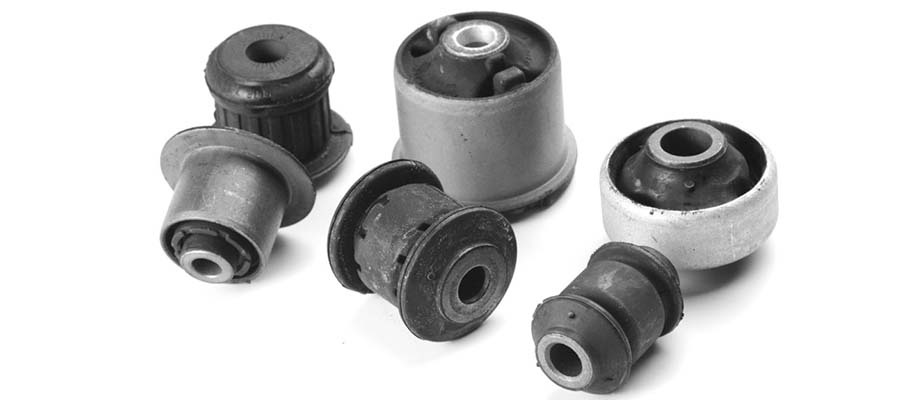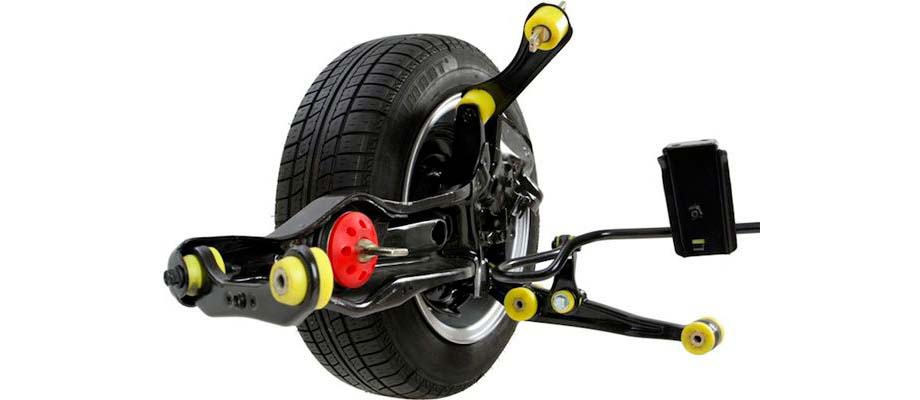
What is a silent block and in what cases it needs to be changed
In this article, we will talk about a simple and inconspicuous part called a silent block. Although there are quite a few of them in a car, they are not immediately noticeable to the untrained eye, especially when they are covered in dirt. And for some, even the word “silent block” itself may turn out to be new. However, this detail is very important.
The silent block consists of two metal bushings - external and internal, between which an elastic material is pressed by vulcanization - usually rubber or polyurethane. The result is a rubber-metal hinge (RMH). It happens that glue is used to enhance the adhesion of rubber to metal. Thanks to this part, it is possible to connect moving elements in such a way that there will be no metal-to-metal friction. This means that there will be no creaking and vibrations, and lubrication will not be required.
Strictly speaking, a silent block is a special case of a rubber-metal hinge (RMH). In a conventional RMSH, the possibility of mutual slippage of the components is prevented by pulling the rubber bushing over the metal bushing or its radial compression by the outer race. With excessive load or exposure to adverse external factors, mutual immobility can be broken, and then you can hear the characteristic screech of rubber rubbing against metal.
Thanks to a special mounting technology, the silent block is spared from such a feature, hence the name of this part came from, because “silent” in English means “quiet”. The silent block breaks the “vow of silence” only in one case - when the elastic insert is finally torn.
For the first time, such a device began to be used in their cars by Chrysler in the early 30s of the last century. At first, RMSh were used to reduce the vibration of the internal combustion engine. But the idea turned out to be so successful that soon hinges using metal and rubber began to be installed on machines from various manufacturers. Gradually, RMS migrated to other modes of transport and industry.
The advantages of such hinges are obvious:
- lack of friction and the need for lubrication;
- design flexibility;
ability to dampen vibrations and noise;
- durability and insignificant change in performance over time;
- no need for maintenance;
- dirt, sand and rust are not terrible for rubber.
Silent blocks came in especially handy in connecting the moving components of the suspension. Although here they finally established themselves as the main fastening element only towards the end of the 20th century. The introduction of the technology into mass production required extensive research and development in order to obtain optimal methods of metal and rubber adhesion and the best materials for vulcanization.
In a modern car, you can find many parts consisting of metal and rubber, but not all of them are silent blocks. For example, the so-called “floating” silent blocks are not RMSH at all - by design they are ball joints. There is no elastic element in their device, and rubber serves only to protect against dirt getting inside and lubricant leaking out.
The main habitat of the silent blocks is, here they primarily serve to connect the levers.

In addition, silent blocks are widely used for mounting, rear suspension beams, and also in.
RMSH also allow you to significantly reduce vibration and noise in the mounting of the internal combustion engine, gearbox and other machine components.
The working properties and durability of the use of silent blocks are largely determined by the quality of the elastic material located between the metal bushings.
The best result is the use of natural rubber with various additives that give the desired performance. During the vulcanization process, the rubber turns into rubber and provides a reliable adhesion to the metal.
Recently, more and more often there are RMS, in which polyurethane or its mixture with rubber is used. Polyurethane is stronger than rubber and ages more slowly. It tolerates severe frosts well, when rubber can crack and become unusable. It is resistant to oil and other substances that can damage rubber. For these reasons alone, polyurethane bushings should last longer than their rubber counterparts. At least theoretically.
However, the problem with polyurethane is that most of its grades do not give good enough adhesion to metal. If you got a low-quality polyurethane silent block, the result may be slippage of the elastic insert under load. A creak will appear, but in general, the operation of such a hinge will not be as good as we would like.
If you practice a calm driving style and avoid bad roads, then it is quite possible to get by with rubber hinges.
If you are a fan of driving and do not pay too much attention to road bumps, then you should try polyurethane silent blocks. According to many motorists, the car is better controlled with them, shocks and vibrations are better damped. Although there are those who have a different opinion, believing that silent blocks with polyurethane inserts are less reliable and last less than rubber ones. Most likely, both are right, and it all depends on the properties of the polyurethane used and the quality of the workmanship of the part.
Nominally, silent blocks in most cases must withstand a mileage of 100 thousand kilometers. Under ideal conditions, good quality RMS can “run through” 200. Well, in our realities, it is better to diagnose the state of silent blocks after a run of 50 ... 60 thousand kilometers, or even more often if the car is operated in difficult conditions.
Reduce the life of the RMSH excessive loading of the car, a sharp driving style, frequent arrivals at a significant speed on obstacles in the form of pits, rails, curbs, speed bumps. Sudden changes in temperature and exposure to aggressive substances spoil rubber.
To visually assess the condition of the hinges, you need to drive into the inspection hole or raise the car on a lift. Next, the parts must be washed from dirt and carefully inspected. There should be no cracks, breaks, delaminations or swelling of the rubber, otherwise the silent block must be replaced.
Also, a serious reason for an urgent change will be a backlash in the seat. If this is not done, then the seat will soon be so broken that it will become impossible to press a new hinge into it. Then you will have to spend money not only on the silent block, but also on the part in which it is installed. If you begin to hear knocks in, immediately inspect the hinges and fasteners. Then, perhaps, you will avoid escalating the problem to a more serious level.
Indirectly, the behavior of the car on the road can speak about troubles with silent blocks. There may be a delay in response to turning the steering wheel and leaving the car to the side, especially at high speed.
Another symptom of worn silent blocks is increased noise and vibration in the suspension.
Failed silent blocks lead to a change in position. As a result, the wheel alignment is disturbed, which happens, which can be seen even with the naked eye - the wheels are located in a house. And broken wheel alignment, in turn, leads to uneven tire wear.
But it must be borne in mind that these signs may have other causes. For a more accurate diagnosis, it is better to contact a car service.
Silent blocks, with the exception of collapsible models, are not subject to repair - only replacement. Often there are parts, for example, suspension arms, in which the hinge is an integral part of the structure. then, if out of order, you will have to change the entire part assembly.
On sale It happens that you can find repair bushings for silent blocks. The release of such spare parts is dictated solely by the desire to function on inexperienced and gullible motorists. Because the hinge restored in this way is no good. It does not withstand the load and quickly fails, and at the same time breaks the seat.
For high-quality replacement of silent blocks, conventional tools will not be enough. Pressing and pressing will require special pullers, mandrels, punches and other things. Of course, in skillful hands, a sledgehammer and a piece of pipe of a suitable diameter can work wonders, but the risk of damaging the hinge or breaking the seat is very high. It is possible to purchase a specialized set of tools and fixtures, but the cost is usually such that repairs at a car service center may be cheaper.
In any case, to independently change silent blocks, you will need some experience, especially when it comes to fixing a power unit or gearbox - it is better to entrust this complex and time-consuming work to qualified mechanics.
If you still decide to do the work yourself, you need to keep the following in mind:
The rigidity of the silent block may differ along the radius, in such cases there are mounting marks on its body. When installing, you need to navigate by them or by some conspicuous elements.
During installation, do not use oil or other substances that can damage the elastic insert of the RMSH.
Since the silent block does not belong to the elastic elements of the suspension, it is necessary to exclude its load in the state of average vehicle load. Therefore, the tightening of the silent blocks must be done when the machine is on the ground with its wheels, and not suspended on a lift.
Since new silent blocks will inevitably change the angles of the wheels, after changing them, it is necessary to adjust the alignment.
In order not to ditch the silent blocks ahead of time, it is enough to follow a set of simple rules.
Drive carefully, overcome pits and various obstacles at minimum speed.
Try not to overload the suspension, do not hang the wheels for a long time.
Avoid large suspension swings, especially in cold weather.
Do not overheat RMS, exclude exposure to aggressive substances.
Periodically wash silent blocks, as dust that has got into microcracks contributes to faster wear of rubber or polyurethane.